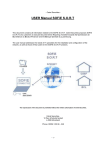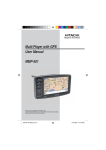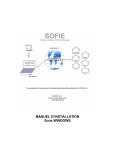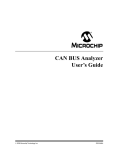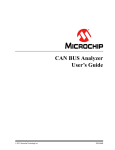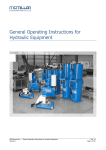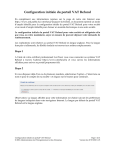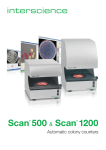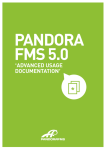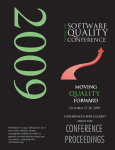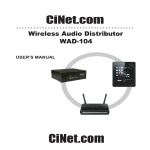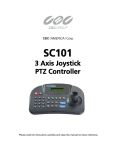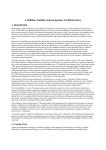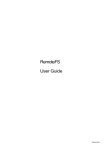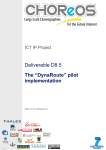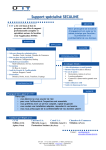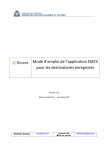Download USER Manual
Transcript
- Cetrel S.C.- USER Manual This document contains all informations related to the SOFiE tool. CETREL proposes SOFiE to its customers to execute Secured Online File Exchanges. The user manual addresses the needs of IT specialists for the installation and configuration of the network, as well as those of final users for the SOFiE functions. The reproduction of this document is prohibited without the written authorization of CETREL S.C. CETREL S.C. 10 Parc d'Activité Syrdall L-2956 Munsbach Phone: 00352 3 55 66 - 444 -1- - Cetrel S.C.- Table of contents USER Manual ................................................................................................................................ 1 Table of contents ............................................................................................................................ 2 Contacts .......................................................................................................................................... 4 Introduction.................................................................................................................................... 5 Basic Functions of the SOFiE tool ......................................................................................................... 5 Installation ............................................................................................................................................... 6 Components ............................................................................................................................................. 7 Technical Requirements ......................................................................................................................... 8 Windows installation............................................................................................................................. 10 User manual ................................................................................................................................. 13 Starting SOFiE ...................................................................................................................................... 13 Login....................................................................................................................................................... 13 Main menu ............................................................................................................................................. 30 Emission ................................................................................................................................................. 33 Receive.................................................................................................................................................... 37 Decryption.............................................................................................................................................. 40 Options ................................................................................................................................................... 42 Input file import .................................................................................................................................... 47 Key renewal ........................................................................................................................................... 48 Cancel Certificate Request ................................................................................................................... 48 User Configuration File Input.............................................................................................................. 49 Import Certificates ................................................................................................................................ 50 Use the import function and select the file containing the certificate............................................... 50 FisEp....................................................................................................................................................... 51 TAF......................................................................................................................................................... 51 Logs......................................................................................................................................................... 52 About ...................................................................................................................................................... 55 Batch mode................................................................................................................................... 56 Batch execution using the config file.................................................................................................... 56 Manual batch execution........................................................................................................................ 58 Tracking the batch processing using the return code ........................................................................ 59 Tracking the batch processing using the Audit Log........................................................................... 59 Useful information....................................................................................................................... 61 Packages ................................................................................................................................................. 62 -2- - Cetrel S.C.- Standalone/Connected mode ................................................................................................................ 62 Change from connected mode to standalone ...................................................................................... 63 SOFiE Architecture............................................................................................................................... 64 Routing ................................................................................................................................................... 66 Verify Certificates ................................................................................................................................. 67 -3- - Cetrel S.C.- Contacts User Help Desk Please contact the User Help Desk for any information you need. Either for the installation or the use of SOFiE. phone: (+352) 3 55 66 - 600 e-mail: [email protected] Commercial Department Please contact the CETREL Commecial Department for any information related to your SOFiE contract. phone: (+352) 3 55 66 - 444 e-mail: [email protected] Please contact the CETREL Securities Commecial Department for any information related to your SOFiE SORT contract. phone: (+352) 3 55 66 - 349 e-mail: [email protected] -4- - Cetrel S.C.- Introduction SOFiE is not only a tool proposed by CETREL S.C. to transfer files in a secured way. CETREL S.C. proposes SOFiE as a complete service allowing SOFiE or SOFiE SORT participants to exchange files with a delimited number of other participants (Cetrel, Centre Commun de la Sécurité Sociale, Tax Administration in Luxembourg, CSSF). For data security, the SOFiE solution relies on CETREL's own Certification Authority (CA) or LuxTrust Certification Authority. Find on www.cetrel.lu or www.cetrel-securities.lu call our HelpDesk or Commercial Department to get all detailled information to adhere to this service. Basic Functions of the SOFiE tool 1) SOFiE implements the main security principles; authentication, non-repudiation, confidentiality and integrity. These security functions are independent from the transfer mechanisms, and so it is possible to use alternative transfer solutions (diskette, tape, ...) without reducing the security level. The functions implemented in SOFiE are based on the IAIK Library [TM] developed by the Technische Universität Graz. 2) SOFiE uses Certificates (X.509), established by the Certification Authority of CETREL or LuxTrust Certification Authority. 3) The transfer mechanisms to send/receive files is based on the HTTP/S protocol. This renders SOFiE independent from difficult network security requirements. 4) To exchange secured files you may choose the "connected mode" when you have a direct communication with CETREL using the Internet or a leased line. You may also choose the "stand-alone mode" configuration, when your data is coming from a highly secured environment. In this case the data is secured on your station and the secured data is sent to your addresse using the medium he accepts. Generally you may use another "connected mode" participant for the data transfer. 5) SOFiE offers a functionality to recognize and verify structured files before the securitization of the contents. This functionality avoids the transmission of incorrectly structured files. 6) SOFiE is capable to distinguish the context of an exchange. In "Production" context the exchange of real operational information is processed. The "Test" context is used to exchange data for test purpose. 7) For the exchange of data, SOFiE participants subscribe to packages. This allows a participant to exchange data only according to rules established for the package (ex. the types of supported files, the participants). The rules for every package are documented and available on www.cetrel.lu. 8) Apart the exchange of secured files, a package may include additional functionalities. - For the tax administration in Luxembourg, Cetrel developed a package that permits users to type in data. Data are formatted into a file, according to the requirements of the tax administration. When data capture is completed, they are securely sent to the tax administration. - For the TAF report, Cetrel developed a package which is commercialized by CETREL Securities that permits users to type in data. Data are formatted into a file, according to the requirements of the CCSF. When data capture is completed, they are securely sent to the CSSF. 10) All detailed informations on the service are available by www.cetrel.lu. -5- - Cetrel S.C.- SOFiE concept Participant: 999900202 (CONNECTED mode) Secured Data Routing eMail Secured Data Participant: Participant: 999900201 (CONNECTED mode) ACD Cetrel CCSS Financial Inst. CSSF Participant: 999900203 (STANDALONE mode) Guaranteed Secured File Transfer The concept of SOFiE is very simple: 1. Any user, having a direct connectivity to Cetrel (here 999900202, 999900201, CCSS, Tax Administration, Banks, CSSF) can exchange secured data with another. 2. Every participant has it's own SOFiE program installed on his infrastructure (server, PC, ...). On this infrastructure the data is secured with the user's private key and the receiver's certificate. 3. The secured file is send to Cetrel, who simply makes it awailable to the receiver. 4. The receiver launches his receipt as he wishes and can only decrypt the files for whom he has the correct private key. Some particular applications of SOFiE are document further in this documentation (Useful information). Installation The installation and configuration process has been simplified and automated at its most. You can get your version of SOFiE either by downloading it from our Website or we can provide you with a CD-ROM. For upgrading your SOFiE version, we use the JNLP [TM] technology via the Webstart [TM] tool . It allows you to get an update of your SOFiE program every time you start the program. The SOFiE modules are electronically signed, protecting you from the delivery of a non-Cetrel version. -6- - Cetrel S.C.- Components JRE [TM] SOFiE uses the Java Runtime Environment. It is the standard JRE as delivered by SUN [TM]. The JRE is automatically installed. Webstart[TM] is a tool delivered by SUN[TM]. It implements the JNLProtocol, to synchronize a program between a client station and the version existing on a webserver. CETREL uses this technique to synchronize the SOFiE program with its customers. Webstart[TM] Webstart verifies the electronic signature of a module. Using this technique, you are always sure that the installed module is coming from CETREL. The certificate is installed automatically during first installation. Additionally, Webstart uses the sandbox mechanism of JAVA. This functionality allows customers to be sure that the SOFiE program has only access to authorised resources of your computer. If you are familiar with this concept, you can yourself change the rights. The SOFiE program consists of a number of signed JAR's. SOFiE The functionalities of the program can be used either by the GUI or via batch mode. -7- - Cetrel S.C.- Technical Requirements Platforms Refer to www.cetrel.lu to get all the information concerning the supporter platforms and the technical requirements for the SOFiE tool. Communication The file exchanges with CETREL are done via an Internet Connection. Any type of communication can be used : leased line, modem, .... !!! Important !!! • To allow the transmission of data, you need to open the following URL and TCP/IP sockets. http://www.cetrel.lu/jws/sofie/index.html https://www.cetrel.lu/cgi-bin/prot/chgpass • To be able to have the automatic update of new SOFiE versions, allow the URL https://www.cetrel.lu/secure/prot/sofie/jsp/servlet/SofieMain • To have access to the LDAP, authorize use of the LDAP protocol with port 389 • If you are using a Proxy, verify that it is working without "user authentication". -8- - Cetrel S.C.- Directory Structure To integrate SOFiE in your automated process, it is important to know the usage of the directory structure, installed and used by SOFiE. Directory 999900**** Archive Error Received received/999900207 to_crypt to_decrypt to_send Keys Logs Properties\batch Properties\clients Recommended actions backup the structure regularly clean the structure regularly backup (for tracing) and clean regularly all files received for the user are decrypted and can be used for further treatment all files received are transmitted to user 999900207 and are not (cannot be) decrypted basic directory scanned every time you execute the encryption process basic directory scanned every time you execute the decryption process basic directory scanned every time you execute the sending process backup regularly contains the log files. You can use the files to monitor SOFiE It is recommended to make a regular backup and clean the directory. backup regularly backup regularly -9- - Cetrel S.C.- Windows installation Prepare the installation Download the Installshield from www.cetrel.lu or get your CD from CETREL . You have to uninstall former SOFiE installations, when reinstalling SOFiE. Log to your computer using your Adminstrator user. The installation of the JRE requires administration rights Download from www.cetrel.lu your SOFiE software using your User-id and Password you got from CETREL. 1. Start the download 2. Confirm with OK and choose the file location - 10 - - Cetrel S.C.If you choose another directory, remember the location of the sofie.exe file The download will start 3. After the download has finished, use your Explorer and double-click on the sofie.exe file, or use the Windows run function Install from the CD. The installation process should automatically start when you insert your CD into the reader. If this does not happen, open the Explorer and double-click on the setup.exe file - 11 - - Cetrel S.C.- Execute Installation 1. The Installshield starts and asks you where to install SOFiE 2. When the installation is finished, a SOFiE icon is added to your desktop automatically started. You will arrive to the Login screen . SOFiE is Other Platform Installation . Use your User-Id and Password to download from www.cetrel.lu your TAR file or get your CD from CETREL. 2. Copy the TAR file to its destination, and execute the UNTAR utility with the instruction: uncompress sofie.verxyz.tar.Z tar -xvf sofie.verxyz.tar 3. The following components have been installed: • the latest JRE [TM] supported by SOFiE (refer to www.cetrel.lu for the actual version) • the SOFiE program 4. Start SOFiE using the run_gui.ksh script. - 12 - - Cetrel S.C.- User manual Starting SOFiE Use the icon on your desktop to start SOFiE. SOFiE is started through Java Webstart [TM]. Every time you start SOFiE, it will try to synchronize your SOFiE version with the reference at Cetrel. When a new version is downloaded, the starting of SOFiE will last somewhat longer (depending on your telecommunication infrastructure). Notice:The synchronization happens only if you have access to the required URL. Login The login allows you to access the functions of SOFiE. 1. Fill in Your User Id and Your Password Remember that the first time you log to SOFiE, you have to type in the password contained in your envelope. During the configuration wizard, you will have to change your password. SOFiE requests that your password will have at least 8 characters, one upper case letter, one lower case letter and a digit. After 3 erroneous attempts, the Login terminates automatically. You can nevertheless restart SOFiE and try to log in again. - 13 - - Cetrel S.C.!!!! Important !!!! If you forget/loose your password once you have created your profile, you can no longer use SOFiE. You must contact CETREL to get a new participant ID. SOFiE saves the status of your user and during the login, according to the status, different functions may only be awailable : LOGIN User in User not configuration defined process Certificate has reached limit date and renewal was not requested New certificate Certificate User defined and was requested expired certificate valid User not defined If the User Id is yet not declared on your computer, you are requested to confirm the creation of the user. Confirm the creation of a new user and you will continue with the configuration wizard Do not confirm the creation of a new user and get the information After confirming with you return to the login screen. - 14 - - Cetrel S.C.- User in configuration process The configuration wizard leads you through all the configuration steps you have to execute before having access to the SOFiE functions. If for any reason you stop during the process, the next time you login, the wizard will automatically guide you to the last configuration step performed. You continue with the procedure. 1. The Disclaimer informs about the responsibilities when using SOFiE Agree and go further with to - 15 - - Cetrel S.C.- 2. The profile creation • • confirm your internet connection when yes, confirm your proxy and give the Host name and the port number of your proxy server (ask your network administrator for these informations) • confirm whether you are connected to the internet • If you have an Internet connection, you are asked to complete: whether you have a proxy server and give the Host name and the port number of your proxy server (ask your network administrator for these informations) go further with to - 16 - - Cetrel S.C.3. You are requested to change the password Repeat your old password and fill in your new password (respect the rules for declaring a password). Repeat your old password, and introduce your new password (respect the rules for declaring a password). Notice: Your password for accessing the protected Internet site of CETREL has also been changed and continue with to - 17 - - Cetrel S.C.4. Fill in your personal informations and select your Certification Authority Notice: For SOFiE Business Contract, the Certification Authority is CaCetrel Be sure that you fill in the information as mentioned on your contract. These informations will be used for your certificate request, and the CA_Cetrel will refuse your certificate request if informations are wrong. Name: E-mail: Company: Department: City: Country: Mail server: your name your e-mail address (the certificate will be sent to this address) company name your department your city your country name of your mail-server (consult your network/system administrator) FOR SOFiE SORT Contract, the Certification Authority is LuxTrust Be sure that you fill in the information as mentioned on your communication with LuxTrust. These informations will be used for your certificate request, and LuxTrust could refuse your certificate request if informations are wrong. continue with to - 18 - - Cetrel S.C.5. Confirm your personal informations and the Certification Authority continue with to 6. Generate your private/public key - 19 - - Cetrel S.C.- continue with to For CA_CETREL 7. Send the Certificate request either automatically if you have an internet connection (option fixed in the first screen) either save the certificate request with the filename = your Participant Id. and send the file manually by email to [email protected]. - 20 - - Cetrel S.C.- 8. CA-CETREL will send you by email the “SOFIE.CONFIG” file, containing your certificate and your profile. 9. The next time you start SOFiE, you will be guided to Load requested Certificate For LuxTrust 7. Save Certificate request for LuxTrust - 21 - - Cetrel S.C.The format of certificate request is the format .pem required by Luxtrust 8. The first phase of your configuration process has been executed and SOFiE is stopped. 9. Send your Certificate request to LuxTrust and retrieval your certificate certified by LuxTrust. Following the instruction defined on : https://www.luxtrust.lu/fileadmin/user_upload/downloads/SSL_guide_online.pdf. Notice : You can download your certificate in format .der or .pem 10. Upload your certificate on www.cetrel.lu under SOFiE heading If the upload is correct, you receive a confirmation - 22 - - Cetrel S.C.- Else you receive an error page 10. CETREL will send you by email the “SOFIE.CONFIG” file, containing your certificate and your profile. 11. The next time you start SOFiE, you will be guided to Load requested Certificate Certificate has reached limit date and renewal was not requested 1. SOFiE detects that your certificate will soon expire (1 month), and asks if you want to renew - 23 - - Cetrel S.C.your Certifiacte will start the application will 2. Generate a new private/public key continue with to For CA-CETREL 3. Send the Certificate request either automatically if you have an internet connection - 24 - - Cetrel S.C.- either save the certificate request with the filename = your Participant Id. and send the file manually the mentioned email address 4. The first phase for your key renewal process has been executed. CA-CETREL will send you by email a file containing your certificate. The next time you start SOFiE, you will be guided to New Certificate requested. - 25 - - Cetrel S.C.- For LuxTrust 4. Send your Certificate request to LuxTrust and retrieval your certificate certified by LuxTrust. Following the instruction defined on : https://www.luxtrust.lu/fileadmin/user_upload/downloads/SSL_guide_online.pdf. Notice : You can download your certificate in format .der or .pem 5. Upload your certificate on www.cetrel.lu under SOFiE heading If the upload is correct, you receive a confirmation - 26 - - Cetrel S.C.- Else you receive an error page 6. CETREL will send you by email the “SOFIE.CONFIG” file, containing your new certificate and your profile. 7. The next time you start SOFiE, you will be guided to New Certificate requested. - 27 - - Cetrel S.C.- Certificate expired 1. SOFiE detects that the certificate has expired. will start the application, but you will not be able to encrypt and send any file will either invite you to load a requested certificate, or to renew your certificate Load requested Certificate 1. After starting the application, you are requested to load the “SOFIE.COFIG” file, you received from CETREL Select the file and continue with - 28 - - Cetrel S.C.2. SOFiE is installing your certificate. The configuration wizard will finish with this screen 3. SOFiE is started automatically Change password It is recommended that you change your password regularly. If you think that someone else was able to access your password, modify it immediately. 1. After starting the application, choose the option Change Password 2. Fill in and confirm with your new Password. - 29 - - Cetrel S.C.- Main menu You can access to the functions using the menus or using the different shortcuts. Access to functions depends whether you have an Internet connection, and that the certificate has not expired. - 30 - - Cetrel S.C.The main menu of SOFiE gives access to the different functions of SOFiE 1. Processing of files The Emission functionality allows you to encrypt and/or send files to a destinator. The Receipt menu gives you access to the Receive and Decryption functionality. 2. The Tools menu gives access to - 31 - - Cetrel S.C.- the different Settings to customize SOFiE according to your needs - the functionality to execute the key renewal and to load a new configuration file - the functionality to consult the different logs ( log console , audit log ) - the access to the FISEP – GUI 3. The Help menu informs you - Gives you access to the Help - Gives you details about the program version - 32 - - Cetrel S.C.- Emission The Emission function allows you to encrypt and/or send files to the destinator. Start the emission process 1. Choose on the toolbar the Emission option - 33 - - Cetrel S.C.- 2. Choose the context in which you want to use SOFiE. !!!! Be aware that when you use the test mode, the receiver will probably not automatically treat your files. The test context mode should only be used to exchange files for test purposes!!!! 3. Establish the list of files you want SOFiE to treat Select the directory where your files are located and use the to add all the files contained in the directory to your list button or button to add the file to your list. Select the specific file and use the You can also use the normal Windows options for selecting directories and files (Shift + select, Ctrl + select, ....) When adding the file(s) to your list, SOFiE executes automatically the automatic recognition for file contents. If the destinator has not been detected automatically, according to the rules (i.e. type free), you must select the destinator yourself. SOFiE allows you to choose among the known destinators. Refer to the documentation of file format and naming conventions for the files supported by the different packages. The documents are awailable on www.cetrel.lu or can be requested at Cetrel. 4. Choose whether you want to encrypt and/or send the files If in point 3., you selected files that have already been secured by SOFiE in a preceding action, the files are not secured a second time, but sent as are to CETREL. Only encrypted files are sent to CETREL. If files that are not secured by SOFiE have been selected, and you request only the sending, the files are not transferred. - 34 - - Cetrel S.C.5. Confirm with , to start the encryption/send process. Follow the emission process 1. After starting the emission process, SOFiE attaches the Follow-up screen. 2. The complete list of all the selected files is attached. According to the automatic processing of SOFiE, the status of the files is attached. • • • • • In progress : Crypted : Sent : Error : Report : The file is about to be treated by SOFiE The file is crypted (only if the Crypt option has been set) The file is sent (only if the sent option has been set) The file, that for any reason could not be treated correctly Have direct access to the informations, that allow you to find out why the processing of your file did not work 3. When the processing of all the files completes, you can print a report containing the information of all processed files. !!!! Print out the report immediately, you will not have the opportunity to request the reprint of the report!!! - 35 - - Cetrel S.C.- 4. When you close the window, SOFiE is asking you if you want to start the Receipt. Notices: 1. The original files are not deleted by SOFiE. 2. When the Emission process is interrupted, SOFiE does not fulfill a rollback, meaning that files that are sent have arrived to CETREL. Files that are encrypted are in the encrypted Directory. 3. The files that have been treated with an error are put into the Error Directory of your Participant Id. 4. The files that result from an encryption process are stored in the Crypted Directory. 5. All treated files (the original version) are stored in the Archive\to_crypt directory. 6. All sent files are stored in the Archive\to_send directory. 7. If you need your report in an electronic way, use the possibilities of the printer configuration. 8. All the files are renamed along a specific SOFiE rule, when they are encrypted. The standard is <<SOFIE.timestamp.Id destinator>>. 9. As a user you need to know the receiver of your file in terms of "who will have access to the content of the file". The potential intermediary (Routing concept ) on the receiver's side is not an important information for you. - 36 - - Cetrel S.C.- Receive The Receive function allows you to receive all the files that have been sent to you. 1. Choose the Receipt/Receive function 2. Start the Receipt by pushing on the button - 37 - - Cetrel S.C.3. The following message informs you, in case no file is available for you 4. Otherwise the files with their respective processing status are attached • • • • In progress : Received : Decrypted : Error : The file is about to be treated The file is received The deciphering process is executed An error occurred and the error report should be considered - 38 - - Cetrel S.C.5. Files sent to you are stored as follows \Decrypted\ \production \test files sent in production context are stored here files sent in test context are stored here \Received\9999..... files that are to be routed to another destinator are stored in a seperate directory 6. When the processing of all the files completes, you can print a report containing the information of the files that have been processed. !!!! Print out the report immediately, you will not have the opportunity to request the reprint of the report!!! Notices: 1. If any problem occurs after the receiving process, the secured file is copied in your ...\to_decrypt directory. Consult the error report to find out the reason for the problem. Use the Decryption Functionality after resolving the problem. 2. All the files that have been received are named along a specific SOFiE rule. The standard is <<SOFIE.timestamp.Id Destinator>>. When the file has been deciphered, it will get a name according to the SOFiE Naming functions - 39 - - Cetrel S.C.- Decryption The functionality permits the decryption of secured SOFiE files. The secured SOFiE file has been transmitted to you by using the SOFiE routing mechanism or if during the Receipt process, an error occurred when SOFiE tried to decrypt the file. 1. Choose the Receipt/Receive function 2. Establish the list of files you want SOFiE to treat Select the directory where your files are located and use the to add all the files contained in the directory to your list button or button to add the file to your list. Select the specific file and use the You can also use the normal Windows options for selecting directories and files (Shift + select, Ctrl + select, ....) 3. Confirm with OK to start the decryption process - 40 - - Cetrel S.C.- • • • • Process : The file is about to be treated Decrypted : The file has been decrypted Error : The file has not been treated correctly Report : Have direct access to the informations, that allow you to find out why the processing of your file did not work 3. When the processing of all the files completes, you can print out a report containing the information of the files that have been processed. !!!! Print out the report immediately, you will not have the opportunity to request the reprint of the report!!! - 41 - - Cetrel S.C.- Options Options - Gui Settings 1. Choose on the Tools Menu, the Options !!!!If you have any doubt concerning the correct understanding of a property, don't hesitate to contact CETREL!!!! - 42 - - Cetrel S.C.- Options - Log Settings 1. Choose on the Tools Menu, the Options !!!!You should have good knowledge of the LOG4J tool, if you want to change the configuration for the log management. Contact CETREL in case you have special needs! - 43 - - Cetrel S.C.- Options - Users Settings 1. Choose on the Tools Menu, the Options !!!!If you have any doubt concerning the correct understanding of a property, don't hesitate to contact CETREL!!!! - 44 - - Cetrel S.C.- Options - Batch Settings 1. Choose on the Tools Menu, the Options !!!!If you have any doubt concerning the correct understanding of a property, don't hesitate to contact CETREL!!!! - 45 - - Cetrel S.C.- Options - HTTP Settings 1. Choose on the Tools Menu, the Options - 46 - - Cetrel S.C.- Input file import In standalone mode, a set of configuration parameters allow you to configure SOFiE in order to use the encryption functionality (certificates). CETREL put in place a simple way to allow you to change the configuration. In the case (key renewal of your destinator, change of your contract, ....), your configuration has to be changed, CETREL automatically sends you a new configuration file. The file is sent by mail, and mentions all the steps you have to execute. 1. Select the configuration file SOFIE.CONFIG 2. SOFiE imports the file and updates your configuration - 47 - - Cetrel S.C.- Key renewal The renewal of your certificate is a process that you will have to repeat in function of the useful life of your certificate , before the certificate is expired. !!!!!!SOFiE automatically advertizes (1 month in advance) during the login procedure, whether your key will soon come to expiration. You can use your certificate until the date of expiration without any limitation. When the certificate is expired, you can only receive files. The encrypting and sending functionality is prohibited.!!!!! !!!If you have any doubt about the revelation of your password, contact as soon as possible Cetrel and renew your key immediately!!! As mentionned in your SOFiE contract and your SOFiE SORT contract, you are responsable for the correct management of your password. Cancel Certificate Request As already mentioned, SOFiE manages the status of your user (refer to Login). If you did launch a Certificate Request using the Key Renewal function, you can cancel the certificate requestion. Choose in the tools menu the "Cancel Certificate Request" option. SOFiE asks you to confirm After confirming, please contact the CA-Cetrel or LuxTrust as requested - 48 - - Cetrel S.C.- User Configuration File Input The usage of this function may be useful in two circumstances: • You have been renewing your key and when logging to SOFiE you did not yet have received your sofie.config file or you asked SOFiE to continue logging in. Now you want to finalize your key renewal by importing the new certificate, included in the new sofie.config file. • You are working in non-LDAP or stand-alone mode and some modification of your interaction with other SOFiE participants has changed. Cetrel is sending you a new sofie.config file. You have to import this file as soon as possible. Otherwise it may be possible that your next sending of files may cause problems (at the destinator). When using on the tools menu the user configuration file input, SOFiE requests you to confirm the location of the sofie.config file you have been receiving by mail from Cetrel. !!! We highly recommend you to install as soon as possible any sofie.config file, Cetrel is sending you. The non-installation may have impacts on your next file transfer. Cetrel may not me hold responsible for any damage if you do not following this instruction!!! - 49 - - Cetrel S.C.- Import Certificates This function allows you to import new root Certificates form the Cetrel Certification Authority. The new root Certificate of CA-Cetrel has been sent by mail or is available on www.cetrel.lu When using on the tools menu the option "Import Certificates", Use the import function and select the file containing the certificate - 50 - - Cetrel S.C.- FisEp The FisEp package has been integrated to SOFiE to allow Paying Agents to conform to the Luxembourg law on savings tax. The SOFiE tool is accepted by the Luxembourg Tax Administration to allow Paying Agents send them the files in the context of the mentionned law. Cetrel added to the basic file exchange functionality a specific user interface that allows Paying Agents to manage their declarations (concerned by this law) using SOFiE. This particular user-interface is only accessible to SOFiE-participants having subscribed to the FisEpSaisie package. A particular documentation is available for this SOFiE package. TAF The TAF package has been integrated to SOFiE tool to allow Financial Institution to conform to CSSF circulaire on TAF report. The SOFiE tool is accepted by CSSF to allow Financial Institution send them the files in the context of the mentionned circulaire. Cetrel added to the basic file exchange functionality a specific user interface that allows Financial Institutions to manage their declarations using SOFiE. This particular user-interface is only accessible to SOFiE-participants having subscribed to the TAF GUIpackage. A particular documentation is available for this SOFiE package. - 51 - - Cetrel S.C.- Logs Technical Log SOFiE manages a log, where all the errors/warnings generated by the program are saved. The log can be accessed either by the GUI or directly by a Text editor in the directory ...\logs\. 1. Choose on the Tools Menu, the Display Log Console 2. You can change the type of messages, that the Log Console attaches, by selecting the desired Message Level . 3. With Clear you can reinitialize the Log console - 52 - - Cetrel S.C.- Audit Log SOFiE manages a special log, which traces for you all the file exchanges that occur. The log can be accessed either by the GUI or directly by a Text editor in the directory ...\logs\log_audit. 1. Choose on the Tools Menu, the Audit Log The log files SOFiE uses the LOG4J utility to generate and organize logging. It is possible to configure the logging according to specific needs. Such an action should only be done in collaboration with CETREL S.C. Different levels for logs are generated according to the properties settings. Log level « debug » Explanation • • Detailled information of the processing Is normally used in development, testing or problem resolution to find and resolve a particular problem in the processing - 53 - - Cetrel S.C.- « warn » • • • • « error » • • « info » « fatal » Synthetic information about the processing Informs that a praticular step in the processing has been executed Is normally used to have an overview of the processing Information that the application got an error that does however not make any doubt about the correct processing. The message should be investigated to find the precise reason An error occured, but the application continues to work • Critical error message that normaly ends up in stopping the application Differents logs are produced in the directory ..\cetrel\sofie\logs. !!!! We recommend that you backup the log regularly. It can be used as a tracing tool for all your activities. It could be useful if you are at odds with another participant about a file exchange.!!!! - 54 - - Cetrel S.C.- About The About screen gives you a reference of all the program modules, which are installed for SOFiE - 55 - - Cetrel S.C.- Batch mode The functions of SOFiE can also be integrated into an automated working environment, as it is often necessary for files that are processed in an automatical way by external systems. To work in an automated way, SOFiE has created during your first Login the basics for the Batch mode usage. In batch mode, you can only access to non-interactive functions, being the emission/receipt and the receive/decryption functions. These basics consist in creating a script, putting your passwords in a securized file, and creating a properties file, that can be modified by the User Batch Settings . The script is located in the ...\bin directory, and is names run_batch_participant ID.bat Batch execution using the config file To exiecute the batch mode in this form, start the run_batch_userid.bat/ksh script. It will execute SOFiE using the batch.config file. Description of the batch.config file sofie.client.batch.999910003.useContext=Production Context used for encrypting files (Production or Test). After decryption, the required directories are created automatically and files stores according to the context. Mandatory Case sensitive sofie.client.batch.999910003.STOP.filename=sofieBatch.stop Name of the file that indicates to SOFiE to stop the processing. The file must be put in the installation directory (default c:\cetrel) Optional. sofie.client.batch.999910003.toDecrypt.refused.filter1=*refused Filter of files that are refused for decryption Only the special character “*” is accepted at the first and/or the last position Æ *.doc : the files ending by .doc are not decrypted (case sensitive) Æ FISE.* : the files beginning by FISE. are not decrypted (case sensitive) Æ *doc* : the files with doc in their name are not decrypted (case sensitive) If no value, all the files are not decrypted sofie.client.batch.999910003.receipt.activated=yes Activate the receipt of files Mandatory (yes/no) If no, SOFIE will not unload waiting files No case sensitive sofie.client.batch.999910003.encryption.activated=yes Activate the encryption of files Mandatory (yes/no) If no, SOFIE will not encrypt the files to send No case sensitive sofie.client.batch.999910003.decryption.activated=yes Activate the decryption of files Mandatory (yes/no) If no, SOFIE will not decrypt the files received No case sensitive - 56 - - Cetrel S.C.sofie.client.batch.999910003.waiting.time=5000 Waiting time (milliseconds) in the processing If no value, the default value will be 5000 sofie.client.batch.999910003.fileSwitch=no Activation of fileswitch Mandatory (yes/no) No case sensitive. If yes, if the batch is not able to detect type and the receiver, it puts the file in the directory defined by clear.folder sofie.client.batch.999910003.toCrypt.folder=\\cetrel\\sofie\\data\\999910003\\to_crypt Directory containing the files to encrypt and send Mandatory sofie.client.batch.999910003.toDecrypt.folder=\\cetrel\\sofie\\data\\999910003\\to_decrypt Directory containing the files to decrypt Mandatory sofie.client.batch.999910003.clear.folder=\\cetrel\\sofie\\data\\999910003\\clear Directory containing files that are not treated by the batch when fileswitch is activated sofie.client.batch.999910003.toCrypt.refused.filter1=*refused* Filter of refused files to be encrypted Only the special character “*” is accepted at the first and/or the last position Æ *.doc : the files ending by .doc are not encrypted (case sensitive) Æ FISE.* : the files beginning by FISE. are not encrypted (case sensitive Æ *doc* : the files with doc in their name are not encrypted (case sensitive) If no value, all the files are not encrypted sofie.client.batch.999910003.STOP.file.delete=yes Flag indicating the deletion of the stopping file for the batch mode Mandatory (yes/no) If Yes, when the batch finds the file defined in STOP.filename, it stops and deletes this file. sofie.client.batch.999910003.toDecrypt.accepted.filter1=SOFI.* Filter of files accepted for decryption Only the special character “*” is accepted at the first and/or the last position Æ *.doc : only the files ending by .doc are decrypted (case sensitive) Æ FISE.* : only the files beginning by FISE. are decrypted (case sensitive) Æ *doc* : the files with doc in their name are decrypted (case sensitive) If no value, all the files are decrypted sofie.client.batch.999910003.run.forEver=yes Flag for activating/deactivating the processing of the batch Mandatory (yes/no) If yes, the batch runs until it finds the file defined in STOP.filename sofie.client.batch.999910003.toCrypt.accepted.filter1=*.* Filter of files accepted for encryption Only the special character “*” is accepted at the first and/or the last position Æ *.doc : only the files ending by .doc are encrypted (case sensitive) Æ FISE.* : only the files beginning by FISE. are encrypted (case sensitive) Æ *doc* : the files with doc in their name are encrypted (case sensitive) If no value, all the files are encrypted sofie.client.batch.999910003.sending.activated=yes Activation flag for the sending of encrypted files Mandatory (yes/no) No case sensitive If no, SOFIE will not send files - 57 - - Cetrel S.C.- Remark: This form of using the batch mode allows the automatic synchronization of your SOFiE software with the reference at Cetrel. The first time the complete SOFIE executables are downloaded. Afterwards, only upgraded modules are loaded. Manual batch execution To execute the batch mode, start SOFiE using the _run lu.cetrel.sofie.client.SofieMain #options# command. The options that can be given are: Parameter Possible Values Default Description gui execution mode In batch execution, the value must be always batch (gui is the default value used by the GUI application) -mode gui batch -user your Userid profile that has to be used to execute the batch -file filename name of the file that has to be treated Encrypt Only if a filename present. This option can’t used with -d Send file Only if a filename present Decrypt file Only if a filename present. This option can’t used with -e -e -s -d -ctx Production Test One of the 3 actions must be indicated. Remember the following rules: • you can only encrypt files that have not been encrypted by SOFiE before • you can only send files that have been encrypted • you can only decrypt files that have been encrypted before - 58 - is be is is be - Cetrel S.C.- Ex.: run_batch -mode batch -user cm0252 --> will launch SOFiE and treat all the files you put in the configured directories run_batch -mode batch -user cm0252 -e simple_file.FREE.99990003 --> will launch SOFiE and encrypt the file simple_file.FREE.99990003 with the private key of cm0252 and the certificate of 99990003. The resulting file will be named SOFIE.timestamp.99990003 and must be transmitted to the destinator. run_batch -mode batch -user cm0252 -d SOFI.200212091211001.cm0252 --> will launch SOFiE and decrypt the file SOFI.200212091211001.cm0252 as far and the private key of cm0252 corresponds to the certificate that has been used by the sender to encrypt the file. The resulting file will be named according to the original name, or if a special naming convention has been implemented for the user cm0252. Remark: This form of using the batch mode allows the automatic synchronization of your SOFiE software with the reference at Cetrel. The first time the complete SOFIE executables are downloaded. Afterwards, only upgraded modules are loaded. Tracking the batch processing using the return code Also in batch mode, SOFiE is generating messages that are put in the same log as the user-interface execution. When stopping, SOFiE is returning a system code, indicating whether file(s) have been treated without errors. The values of the return code are: • 0 if no error occurs • the number of files in error Specific reports concerning the processing of each file can be found in the UserId\error\.... Directories. They are the equivalent of the Emission/Receive Report. Tracking the batch processing using the Audit Log The audit log (...\logs\log_audit.log) contains all the information that allows a tracking of the processing of SOFIE. The explanation of the different messages are: << 24 mars 2005 13:02:33 [audit.lu.cetrel.sofie.client.SofieClientSideCommunication] - - 59 - 0 files - Cetrel S.C.available on server for user login: 999910003 : >> No file was available on the server for the requesting user << 25 mars 2005 09:57:36 [audit.lu.cetrel.sofie.client.SofieClientSideCommunication] - 1 files available on server for user login: 999910003 : SOFI.05032508402466.999910003 25 mars 2005 09:57:37 [audit.lu.cetrel.sofie.client.SofieClientSideCommunication] - < < received file: SOFI.05032508402466.999910003 (acknowledgement sent), login: 999910003, size: 7135 bytes, saved as: \cetrel\sofie\data\999910003\received\SOFI.05032508402466.999910003 25 mars 2005 09:57:37 [audit.lu.cetrel.sofie.client.SofieClientSideCommunication] - < < SOFiE file name = SOFI.05032508402466.999910003 - Original file name = RLAE.2005032527083801.999910003 >> SOFiE received an information from the server that there is one file available SOFiE receives the file from the server and saves it on the platform SOFiE verifies the file and saves it it’s final form on the server << 6 avr. 2005 11:51:04 [audit.lu.cetrel.sofie.client.SofieClientSideCommunication] - > > SOFiE file name = SOFI.05040611505280.999910003 - Original file name = SNOCS.DTA 06 avr. 2005 11:51:05 [audit.lu.cetrel.sofie.client.SofieClientSideCommunication] - > > sent to: cetrel_sofie_server, login: 999910003, file: \cetrel\sofie\data\999910003\to_send\SOFI.05040611505280.999910003, size: 21122 bytes >> SOFiE has detected a file to encrypt and send SOFIE has encrypted and sent the file - 60 - - Cetrel S.C.- Useful information Sending After sending, the files are not deleted in the original directory Receiving You must delete yourself the files from the receiving directory. Otherwise SOFiE may not be able to receive another file containing the same name Multiple You need to install SOFiE once on a computer. You may declare multiple users on the users/install same computer, with the same SOFiE installation ations Informations in these directories must be backed up regularly \data\user1\*.* Backup \keys\*\*.* \logs\*.* The status of every user is maintained and is a basis for SOFiE to manage the different configuration steps the user has to fulfill before accessing to the de/encryption and sending/receiving functions. SOFiE distinguishes: • User not declared • User in configuration process Status • Certificate has reached limit date and renewal was not requested • New Certificate was requested • Certificate expired • User defined and certificate valid - 61 - - Cetrel S.C.- Packages SOFiE integrates (refer to the SOFiE Architecture ) a certain intelligence for recognizing, validating and naming files. Before version 2.5 of SOFiE, this functionality was attached to the concept of file type. Indeed, to every file type, SOFiE attached a required naming convention for the sender, a required format of the content of the file and finally used a defined naming convention for the receiver. The main idea behind this function is, according to the requirements of the receiver given to Cetrel, to refuse invalid files at the sender's premises. Thus avoiding the unnecessary phone calls and retrials. In the end, SOFiE had to support plenty of file types, and it became difficult to maintain a good understanding of them all. Beginning with version 2.5. SOFiE is bundling the multiple file types into packages. So a package: • is a particular service, the SOFiE participant is subscribing in his contract • is a particular service that may be billed (refer to the official price list) • is a particular service, allowing the exchange of files between defined participants (Closed User Group) • is a particular service, where only defined file types may be exchanged A list of all the packages and a detailled description of all the packages is awailable at Cetrel. Standalone/Connected mode The concept of the standalone/connected mode has been introduced to respond to very high security needs that may occur. It may happen that the data you want to exchange with another SOFiE participant is located in a very highly secured environment. This environment is even not connected to a network. Nevertheless in certain cases you have to exchange data with someone else. Using a standalone installation or combining it with the SOFiE's routing concept, you can nevertheless exchange data with other people in confidence. In the standalone mode, the functions needing a network connection are de-activated, and are replaced by manual functions. Standalone Same installation process Installation Version synchronization Connected Synchronized to a local reference version --> no automatic version update - 62 - Synchronization is done to the reference version at CETREL - Cetrel S.C.Configuration Send/Receive Certificate Exchange of data Input file import No access to the Webserver No access to the LDAP --> Requires the import of configuration date (Input file import) Not possible --> only encryption/decryption Access to the Webserver Access to the LDAP Possible Certificate request is saved as a file and sent to CA-CETREL by another station Automatic sending of certificate request data is not exchanged by network, but by another medium (diskette) Date is exchange via the network (send, receive) Imports your certificate, certificates of your destinators and configuration file to define your destinator Imports only your certificate, as other informations are on the LDAP !!!!! It is recommended to use the standalone mode only for special purpose!!!!! Change the mode You can change the mode, but you must respect the procedure, otherwise your installation will no longer work. Change from standalone to connected mode 1. Contact CETREL and proceed to a change of contract 2. Modify the parameter in the options 3. Verify that you are connected to a network Change from connected mode to standalone 4. Contact CETREL and proceed to a change of contract 5. Modify the parameter in the options 6. You will receive from CETREL a mail, giving your configuration file. Use the input file import functionality. 7. SOFiE will no longer give you access to the send/receive function. - 63 - - Cetrel S.C.- SOFiE Architecture The architecture of SOFiE has been built according to modern software reuse principles. It isolates the different problems in order to encapsulate and give the responsibility of the problem resolution to the different components. Therefore GUI, business, securization, communication and other problems are solved by dedicated components. The SOFiE infrastructure The GUI and Batch level give the user access to the functions of SOFiE. The file treatment component is responsible for the correct identification of files, and to propose some automatism as automatic file type detection, destinator detection, file renaming (depending on emission, receiving). The File securization level is responsible in encryption mode for putting your original file into a standard S/MIME V2 format. Therefore it has access to your private key (using the password you used to login) and the certificates of the destinator. In decryption mode it verifies first the signature. Only when the signature has been verified, the decrypted file is put in a file, so giving access to the contents. The File communication level is responsible to exchange files with the webserver. It distinguishes whether your are in standalone/connected mode. In connected mode it opens an HTTP/S connection with your UserId and sends the file to the webserver. If a communication problem may occur, the file will be sent again the next time you start the sending process. In receiving mode it fulfills an acknowledge protocol - 64 - - Cetrel S.C.with the webserver and executes the get for the files. If there is a problem occurring during the process, the protocol between the receiver and the webserver deals with the synchronization. The communication level itself is based on TCP/IP and is therefore independent whether you use a leased-line, dial-up or any other type of connection to CETREL. The webserver at CETREL deals with communication with the SOFiE installations. On one side the servlet handles the incoming and outgoing protocol with the SOFiE participants. On the other side it dialogues with the Gateway. The servlet produces a special log, giving CETREL a trace of every action. The Gateway is a routing instance. It routes files that are directed to CETREL participants directly to the internal network. The others are made available to the outgoing protocol of the servlet. The Gateway gives CETREL online survey of all the files that are routed. - 65 - - Cetrel S.C.- Routing As it is possible to use the encryption/sending and receipt/decryption functions independently, standalone infrastructures have a very simple way to exchange files in a secured way with other SOFiE participants, using the SOFiE routing mechanism (also possible to use other mediums, but it will not be possible for CETREL to guarantee the delivery). To explain the principle, the best is to proceed with an example. Transfer from user 999900201 to CCSS The SOFiE participant 999900201 wants to transmit data to the CCSS but does not have an internet connexion, and therefore has to work in standalone mode. His collegue having the user 999900203 nevertheless has also a SOFiE installation with an internet connexion. The user 999900201 uses the encryption function and selects the CCSS as a destinator of his file. SOFiE detecting that the user 999900201 is not connected to the internet will save the securized file on the disk. The user 999900201 is transmitting the file to his collegue having the user 999900203 by the intermediary of a disquette or another way. The user 999900203 is simply using the sending functionality to transmit the file to the CCSS. As the user 999900203 does not have the private key of the CCSS, he can't access to the contents of the file. Only the CCSS can access to the contents, using his private key. Transfer from the CCSS to user 999900201 The CCSS responds to the user 999900201, by sending back a respons file. The CCSS selects as a destinator the user 999900201. SOFiE automatically detects, that the user 999900203 is declared as an intermediary for every communication with Jos Weber. SOFiE encrypts the file using the certificate of the user 999900201, but sends the file to the user 999900203. Again the user 999900203 does not have the private key of the user 99990020 and he isn't able to access to the contents of the file. After his receipt process, the decrypted file is put in a special directory from which one he can transfer via disquette (or another medium) the file to user 999900201. Only the user 999900201 can with the decryption functionality and his private key decrypt the file. - 66 - - Cetrel S.C.- Verify Certificates To verify if Certificates delivered by CETREL are really delivered by CA_CETREL or LuxTrust, you can verify the contents of a certificate. 8. Double-click on the Certificate file - 67 - - Cetrel S.C.1. Attach the Details and choose the Fingerprint contents Notices: 1. For CA-Certificates, theThumbprint of the Certificate on your installation can be verified against the Thumbprint published on the CETREL Website ( www.cetrel.lu). 2. Refer to SOFiE directory structure to find the location of the certificates. - 68 -




































































